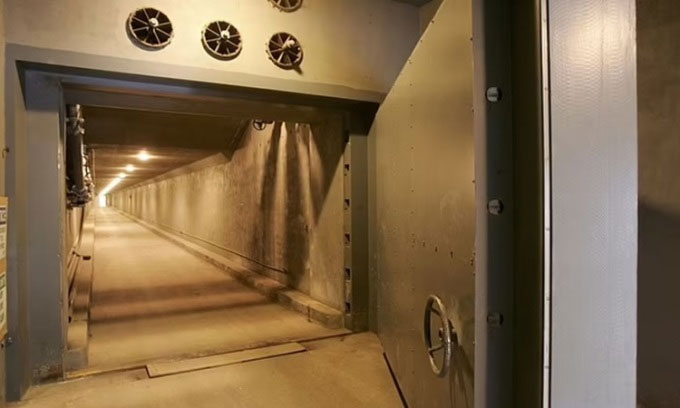Explore the bunker that can contain the entire US Congress
The bunker located under an American hotel was once designed to protect government officials in the event of a nuclear war.

The entrance to the bunker is behind a 28-ton door. (Photo: GreenbrierWV).
The luxury Greenbrier hotel is located in Sulfur Springs, West Virginia, located above an emergency shelter 229m underground , developed in 1958, specifically for American politicians to hide in case of emergency. A nuclear attack occurred, according to Mail . False walls in the hotel hide a 20-28 ton blast door leading to a reinforced concrete shelter containing 1,100 beds, a conference room and an intensive care unit.
The government evacuation facility , nicknamed "Greek Island", once contained six months' worth of food, water and medicine. It is unclear whether the US Congress ever moved into the underground bunker, but the facility was dissolved in 1992 and became a public attraction.
During the Cold War between the United States and the Soviet Union, the risk of nuclear war worried politicians. The U.S. government purchased the resort from the Chesapeake and Ohio Railroad in 1942 and the two-and-a-half-year process of bunkering under the Greek Island project began.
The sprawling underground facility contains everything needed to sustain life in the event of a nuclear attack. The imposing doors protect the people inside from radioactive fallout, bomb explosions or intruders. Some doors are hidden behind wallpaper-covered walls or fake doors. A chemical decontamination chamber inside the entrance will wash away radioactive dust from refugees in the tunnel. In addition to the living room, meeting room and medical room, the facility has an operations room equipped with weapons and communication equipment to ensure the safety of users.
Posing as hotel electrical repairmen, government employees replenished the shelter with supplies over the years. In 1992, when the Washington Post reported on the bunker, interviews with construction workers and government officials revealed the scale of the project. The US federal government quickly dissolved the bunker. After two years of renovation, the facility opened to visitors in 2006.
- The curious life of conjoined twins 200 years ago
- Explore America's superior nuclear bomb shelter
- 10 amazing discoveries about the Sun from the universe
- 3D printed bunker protects astronauts on the Moon
- Indian President will open the World Math Congress
- Cement is smart to withstand both bombs
- History of nuclear disaster shelters
- Ants summon their fellow humans to survive in the bunker
- Close-up of underground survival apartments, where the super-rich swim, watch movies, relax, party, ... waiting for the apocalypse to pass
- Mysterious 50 skeletons intact in the bunker in a 2,000-year volcanic disaster
- Close-up of the bizarre anthropomorphic village in Italy
- With $ 19.5 billion of pumping, many of NASA's missions soon became a reality
 'Fine laughs' - Scary and painful torture in ancient times
'Fine laughs' - Scary and painful torture in ancient times The sequence of numbers 142857 of the Egyptian pyramids is known as the strangest number in the world - Why?
The sequence of numbers 142857 of the Egyptian pyramids is known as the strangest number in the world - Why? History of the iron
History of the iron What is alum?
What is alum?